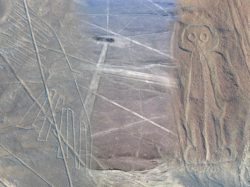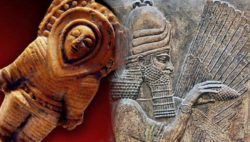
The Hall Of Records And Proof Of Advanced Ancient Civilizations
- By
- May 6, 2017
- September 26, 2021
- 4 min read
- Expert Opinion
- Posted in
- Conspiracy Theory Analysis, Historical
Many people firmly believe that long before recorded history, advanced civilizations were present on Earth. Some believe these civilizations likely to be extra-terrestrial, others that they were human. One thing that all who “stray” into this area agree on, however, is that civilization on Earth likely goes back a lot further than mainstream history states.
What’s more, these civilizations existed not just a few thousand years ago, but hundreds of thousands of years into the past. Further to that, it is also likely, given a number of precise megalithic structures around the planet, that they were technologically advanced.

The Hall of Records under the Sphinx, Egypt?
As an even further twist to these theories are claims that mainstream science actively “covers-up” any evidence of these finds. Authors, Richard Thompson and Michael Cremo, stated exactly that in their book, Forbidden Archeology in 1993.
Contents
The “Forbidden” Claims Of Dr. Virginia Steen-McIntyre
In 1966, Dr. Virginia Steen-McIntyre would claim to have found evidence of civilizations long before previously thought. While working at a site in Hueyatlaco in Mexico, Dr. Steen-McIntyre came across advanced and sophisticated stone tools.
Estimates would suggest the site be around 20,000 years old. Dr. Steen-McIntyre’s results, following four separate testing methods, would state it to be more in line with 250,000 years old. All testing methods utilized by Dr. Steen-McIntyre were accepted by the mainstream. Perhaps strange then that almost entirely, her peers shunned and even attacked her findings. Some even questioned her character in general. In the space of one well-researched claim, she went from a respected archeologist to somebody to keep your professional distance from.
If there were civilizations on Earth millions of years ago – even a quarter of a million years ago as per Dr. Steen-McIntyre’s results – then might they have advanced somewhat over the thousands and thousands of years that followed? We have written before of The Flood, and if it might have actually happened, and more importantly, what type of world existed prior to the event. If civilizations did stretch this far back, might the legends of such lost worlds as Atlantis be true for example?
Before we look at those claims, check out the video below. It takes a short look at the site of Hueyatlaco.
Edgar Cayce and Claims of Atlantis
The first mention of Atlantis in recorded history is through the teachings of the Greek philosopher, Plato. Although mainstream history suggests the claims to be fiction, others believe them to be fact hidden as myth.
More recently, in the early-1930s, mystic, Edgar Cayce, [1] made several remarkable speeches concerning the lost world. What’s more, he would state that survivors of Atlantis had connections to the Ancient Egyptian societies. Many firmly believe in Cayce’s abilities as a prophet, and he has been right on many occasions. He would enter a trance, and from this state, he could access knowledge, both from the past and the future.
Cayce, in one of these trances, would reveal much detail about life in Atlantis. [2]
They were an extremely advanced society – both culturally and technologically. They made use of electrical devices that cut through all known metals and rocks. They also utilized sound wave technology for communication. Even more intriguing, they would travel on vertical and horizontal “elevators of connecting tubes” powered by “compressed air and steam!” They also used “elephant hides” to construct airships that would travel both through air and water.
Perhaps most notably – particularly given the advancements in understanding crystal technology today – are the notions that the Atlanteans utilized such power in combination with the “forces of nature” to serve their society.
So for advanced as they apparently were then, what went wrong? Before we look at that, check out the video below. It features some of Cayce’s predictions and claims.
The Hall of Records
The fall of the Atlanteans appears to be as much to over-indulgence of materials and material wealth, as to an act of nature. Cayce would state that continued mining caused increased plate activity. This plate activity peaked, and “swallowed up” the people of Atlantis “dragging its citizens” to the bottom of the Atlantic. Might this have been The Flood – also a myth for which there is an increasing amount of supportive evidence?
Most of the Atlanteans who had fled to safety would end up in Egypt. According to Cayce, as well as escaping with their lives, those that did survive, brought with them as much of their knowledge and history as they could – a history said to go back millions of years. This is “The Hall of Records” and Cayce would state exactly where to find it – under the paw of Sphinx at Giza. [3]
They would also bring the remnants of their technology. And in part at least, be responsible for the civilization that would flourish over the coming thousands of years. Might this explain the wonder of the Pyramids? According to Cayce, one of the pieces of wisdom that reside in the Hall of Records is instruction on “the art of pyramid building!”
Might the gods of Ancient Egypt actually be the Atlanteans who survived the disaster on Atlantis? Might their technology have been used to give the impression of divinity? There are all questions unanswered, and will likely stay that way without further investigation under the Sphinx’ paw.
The video below looks specifically at Cayce’s claims concerning the Hall of Records.
Secrets of the Sphinx?
Many have tried without success to gain access to the apparent space under the paw of the Sphinx. In 1997, Joe Jahoda and Dr. Joseph Schor appeared to validate Cayce’s claims of an empty space exactly where he said it would be. Their initial examinations would indicate to them that the space was flawless in terms of the “precise 90-degree angles” at the corners. Remember, Cayce, claimed the Atlanteans had technology that could cut metal and rock! Might this have been responsible for these precise angles?
Their application to excavate under the paw would fall on deaf ears. So too, the application of two French archaeologists who had similar claims, including tunnels that ran from the Great Pyramid of Giza to the paw itself.
Maybe the Hall of Records – should it exist – might also tell of The Flood in detail. Recent theories have suggested the Sphinx is much older than mainstream history states it is. Geologist, Robert Schlock, argues that water corrosion around the Sphinx could only have come about through prolonged rainfall.
The last time Egypt experienced the type of rainfall Schlock is talking about, is roughly 10,000BC. This would make them approximately 12,000 years old. Incidentally, around the time many believe The Flood occurred. It might also, if it is ever proven to be true, the fall of Atlantis.
Check out the video below. It is an in-depth look at the theories of Atlantis and where the Hall of Records might be.
Expert Opinion
Supporters of the Hall of Records hypothesis maintain that ancient civilizations flourished far earlier than orthodox timelines acknowledge, possibly stretching back tens of thousands of years or more. Highlighting Dr. Virginia Steen-McIntyre’s controversial discoveries in Mexico and Edgar Cayce’s visions of Atlantis, these believers point to unexplained artifacts, crumbling ruins, and legends of cataclysmic floods as clues of a lost technological heritage buried beneath modern understanding.
Critics, however, emphasize that official archaeology focuses on peer-reviewed evidence and cautious dating methods, a stance that leaves extraordinary claims largely unvalidated. Natural explanations, misinterpretations of unusual geological formations, and the absence of conclusive physical proof prompt many to dismiss these accounts. Although new findings may potentially reshape our historical narrative, at present, the claims of hidden chambers, prehistoric tools, and Atlantean civilizations cannot stand on incontrovertible ground.
Evidence supports the prospect of lost cultures, but mainstream scholarship has yet to confirm their alleged advanced origins.
Marcus Lowth is an expert on this topic and has over 20 years experience studying and reporting in these fields. Marcus has written several books and appeared on TV shows as an expert investigator discussing these topics.
References
| ↑1 | Edgar Cayce On Ancient Mysteries, Edgar Cayce.org https://www.edgarcayce.org/content/the-readings/ancient-mysteries/ |
|---|---|
| ↑2 | Edgar Cayce – Atlantis https://www.crystalinks.com/cayceatlantis.html |
| ↑3 | Edgar Cayce – Great Pyramid and Sphinx https://www.crystalinks.com/caycepyramid.html |
Fact Checking/Disclaimer
The stories, accounts, and discussions in this article may go against currently accepted science and common beliefs. The details included in the article are based on the reports, accounts and documentation available as provided by witnesses and publications - sources/references are published above.
We do not aim to prove nor disprove any of the theories, cases, or reports. You should read this article with an open mind and come to a conclusion yourself. Our motto always is, "you make up your own mind". Read more about how we fact-check content here.
Copyright & Republishing Policy
The entire article and the contents within are published by, wholly-owned and copyright of UFO Insight. The author does not own the rights to this content.
You may republish short quotes from this article with a reference back to the original UFO Insight article here as the source. You may not republish the article in its entirety.





